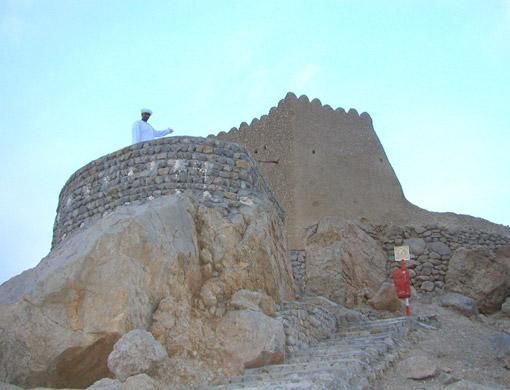Ras Al Khaimah: Dhayah Fort is the only castle standing atop a mountainous dune in the UAE, which was used by ancient tribes as an armed zone to ward off invaders.
Historic records on the Dhayah Fort clearly show that it has been used by guerrillas that fought the invaders. The fort can accommodate limited numbers of people, but it proved historically and militarily successful in facing the invaders.
Emirati historians said many historic books have been prepared on the Dhayah Fort, which was the last area to fall in the hands of the British in their long war against the Al Qawasim tribe. Once Dhayah Fort fell, the British signed reconciliation agreements with the Shaikhs and tribal leaders in the areas.
Access
Emiratis know the Dhayah Fort as one of the key military castles in their history. The fort was built in the 16th century with a strategic location in the northern part of Ras Al Khaimah. The fort, which has direct access to the various roads including the coastal road, other dunes and mountains, is considered key to the emirate.
Historians believe that the residents of Ras Al Khaimah built the fort for resistance and military purposes. The vast majority of historians presumed that the fort was built under the Al Qawasim family that ruled the area. Those historians concluded that it was built in this strategic location to battle invaders. The Portuguese later renovated the fort.
After the fall of the emirate of Ras Al Khaimah in the hands of the British, they moved to Dhayah, which was under the leadership of Shaikh Hassan Bin Ali who fought a historic battle, but Dhayah Fort fell into the hands of British forces on December 22, 1819.
The fort is one of the key historic attractions in the UAE and thousands of people, including tourists from around the world, visit every year.
This has motivated an Emirati to set up a rest house in the area to make the stay of the visitors even more comfortable. The rest house has been provided with all the necessary facilities where scores of Emirati women, who are well informed on the history and value of the Dhayah Fort, receive the visitors and give tours in the site.
The fort has two towers to monitor the movement of the enemy, but lacks a water tanker and that historically indicated that the fighters hiding in the fort did not stay long.
The fort was fully renovated in April 2001 to receive visitors.
The various expeditions assigned to study the Dhayah Fort have discovered many pieces of jewellery, including items made from electrum (a natural mixture of gold and silver).
Nasser Juma'a Abdullah, an Emirati with historic interests, said the fort has attracted expeditions from European countries that are keen to discover the history of the area, and they have found many valuable items that have shed light on the region's history.
One of the key findings from these expeditions was the 'golden Dalayah' (a type of earring) that was later taken to the RAK National Museum.
At the base of the Dhayah Fort an expedition discovered an old 9 x 4.4 metre graveyard, in which they also discovered valuable gold items. This graveyard that was discovered in 1988 is believed to be the biggest among discovered graveyards. The study on this graveyard showed that it was built in the second century BC.
Up till the year 1964, the fort was a home for the ruling family, and it was later used as a central prison until 1984.
Historians believe that the residents of Ras Al Khaimah built the fort for resistance and military purposes. The vast majority of them hold that the fort was built under the Al Qawasim family that ruled the area.












